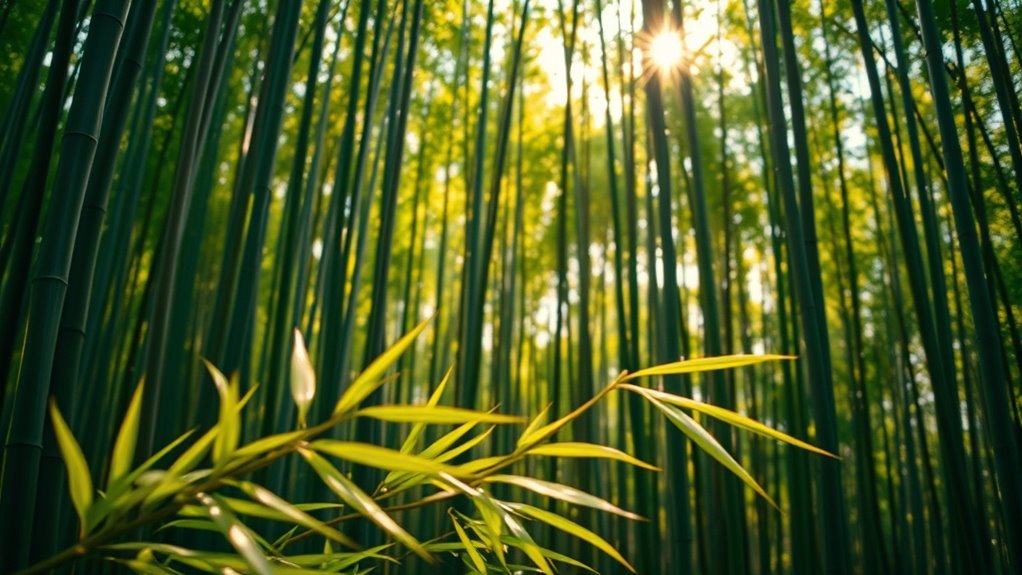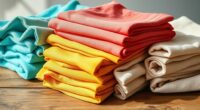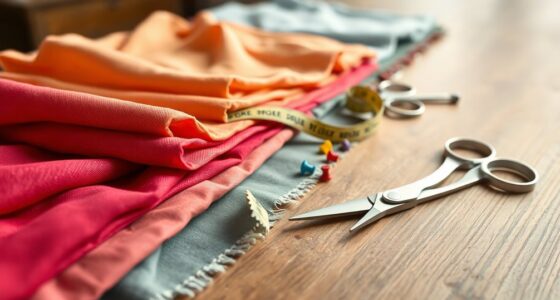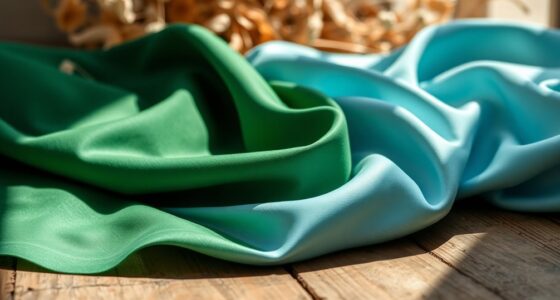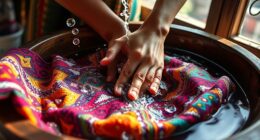While bamboo viscose is often promoted as an eco-friendly fabric, its sustainability really depends on how it’s produced. Bamboo itself grows quickly with minimal water, but the chemical-intensive process used to transform it into viscose can harm the environment if not managed properly. Look for certifications like OEKO-TEX or FSC, which indicate responsible practices. To truly understand its impact and avoid greenwashing, it’s useful to explore how manufacturing methods and certifications influence sustainability.
Key Takeaways
- Sustainable bamboo harvesting depends on responsible cultivation and avoiding overharvesting of mature stalks.
- Chemical-intensive processes in viscose production can harm the environment if not managed with proper waste treatment.
- Certifications like OEKO-TEX and FSC indicate adherence to eco-friendly practices and responsible sourcing.
- Cleaner manufacturing methods, such as closed-loop systems, significantly reduce chemical waste and energy consumption.
- Understanding the entire supply chain helps distinguish genuinely sustainable bamboo viscose from greenwashed products.
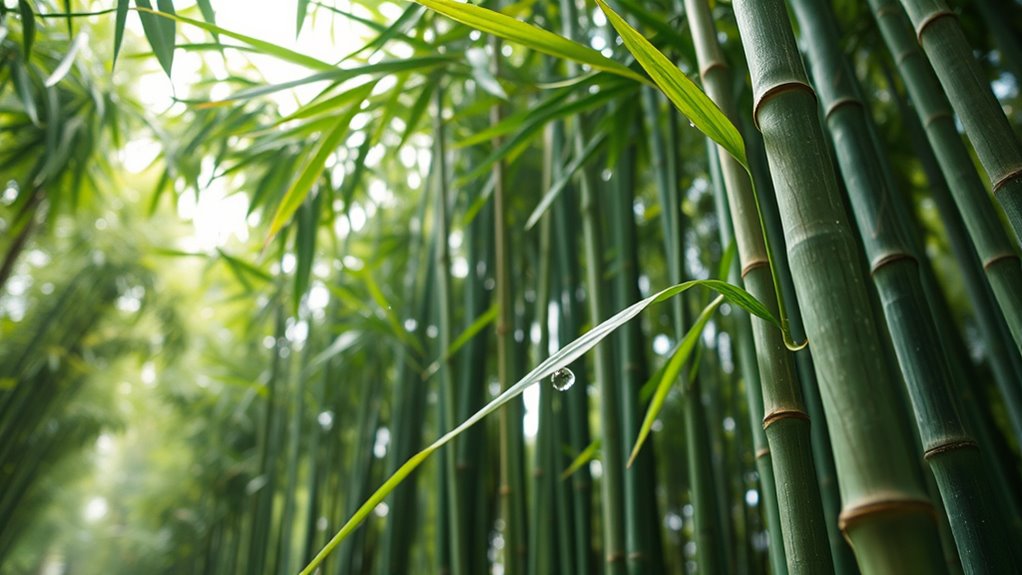
Have you ever wondered what makes bamboo viscose a popular choice for eco-friendly textiles? It’s partly because many people hear “bamboo” and automatically think “sustainable,” but the truth is more nuanced. To truly understand its environmental impact, you need to look at the manufacturing processes involved. While bamboo itself grows quickly and requires minimal water and pesticides, transforming it into viscose fabric involves chemical-intensive steps that can raise environmental concerns.
Bamboo viscose’s eco-friendliness depends on sustainable manufacturing, not just the raw material.
The manufacturing process of bamboo viscose starts with harvesting mature bamboo stalks, which is generally sustainable since bamboo regenerates rapidly from its roots. However, the real environmental impact comes during the conversion of raw bamboo into fabric. To create viscose, the bamboo is broken down using chemical solutions, typically sodium hydroxide, to dissolve the fibers. This step is essential but problematic. The chemicals used are often toxic, and if not managed properly, they can leach into the environment, polluting water sources and harming ecosystems. Some manufacturers have made advances to reduce chemical usage or recycle wastewater, but not all follow best practices, making the manufacturing process a key factor in evaluating eco-friendliness.
You should also consider the energy consumption involved. Producing bamboo viscose requires significant energy inputs, especially during the chemical dissolution and regeneration stages. The carbon footprint of manufacturing can vary widely depending on the facilities and technology used. Some companies implement cleaner processes, such as closed-loop systems that reuse chemicals and minimize waste. Others might overlook these upgrades, resulting in a higher environmental impact.
Despite these concerns, bamboo viscose can still be a more sustainable option than conventional fabrics like cotton or polyester if the manufacturing process is carefully managed. Look for certifications like OEKO-TEX or FSC, which indicate better environmental practices and responsible sourcing. These labels suggest that a company is making efforts to reduce chemical use, recycle wastewater, and lower overall emissions. Additionally, chemical management practices are critical for ensuring environmentally responsible production.
In the end, understanding the environmental impact of bamboo viscose means looking beyond just the raw material. It’s about scrutinizing the manufacturing processes and the steps producers take to mitigate environmental damage. While bamboo itself is a fast-growing, renewable resource, the way it’s processed into fabric determines whether it truly lives up to its eco-friendly reputation. So, when you pick bamboo viscose, ask questions about how it’s made, and support brands that prioritize sustainable manufacturing practices.
Frequently Asked Questions
How Does Bamboo Viscose Compare to Organic Cotton in Sustainability?
When comparing bamboo viscose to organic cotton’s sustainability, you should consider supply chain transparency and water footprint. Bamboo viscose often has a lower water footprint but can involve chemical processing, raising concerns. Organic cotton typically uses less harmful chemicals and has transparent supply chains, but requires more water. So, your choice depends on balancing environmental impact and supply chain practices to make an informed, eco-friendly decision.
What Certifications Ensure Bamboo Viscose Is Sustainably Produced?
You should look for eco labels and certification standards to guarantee bamboo viscose is sustainably produced. Certifications like GOTS (Global Organic Textile Standard) and OEKO-TEX help verify eco-friendly practices, including responsible harvesting and safe chemical use. These eco labels give you confidence that the bamboo viscose meets strict sustainability criteria, helping you avoid greenwashing and support genuinely sustainable products.
Are There Health Concerns Related to Chemicals Used in Processing?
Imagine wrapping yourself in soft, breathable fabric, but be aware that chemical residues from processing can linger, potentially affecting your skin sensitivities. Some bamboo viscose production involves chemicals like formaldehyde and sodium hydroxide, raising concerns about health risks. While many brands use safer methods, it’s crucial to check for certifications and transparency. Knowing this helps you make informed choices, ensuring your comfort and safety when choosing bamboo-based clothing.
How Does Bamboo Viscose Impact Local Communities and Economies?
You can see how bamboo viscose impacts local communities by creating jobs and boosting economic development. When bamboo farms and processing facilities operate locally, they provide employment opportunities, support small businesses, and stimulate regional economies. However, if production relies on large-scale plantations or outsourced manufacturing, it may not benefit the community directly. Your awareness helps you evaluate whether bamboo viscose truly supports sustainable local growth or just benefits outside corporations.
Can Bamboo Viscose Be Recycled or Composted at End-Of-Life?
You might wonder if bamboo viscose can be recycled or composted at end-of-life. While it’s technically biodegradable, its biodegradability potential depends on the processing method used. Most bamboo viscose products aren’t easily composted due to chemical treatments, but some eco-friendly options are designed for better end-of-life options. Recycling is limited, so consider choosing sustainably processed bamboo viscose to reduce environmental impact and enhance its biodegradability potential.
Conclusion
So, next time you reach for bamboo viscose, remember that not everything labeled as “sustainable” is truly eco-friendly. Sometimes, the same plant used for a green image might hide less green realities. Coincidentally, the very process that makes bamboo viscose soft can also be energy-intensive and polluting. Stay curious, ask questions, and dig deeper—because what seems like a natural choice might just be a greener-sounding myth. Your choices really do matter.
